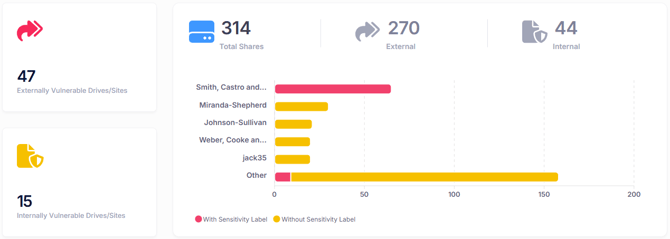Security - Cloud: Data Governance
Insights - Data Governance Report
Overview
The Data Governance report provides a comprehensive analysis of data storage, access, and classification across an organization’s cloud platforms. It helps IT and compliance teams monitor data sensitivity, enforce governance policies, and identify risks associated with unclassified or externally shared data.
Data governance is critical for maintaining security, compliance, and operational efficiency. This report allows organizations to:
-
Track how data is shared across internal and external users.
-
Identify drives/sites and files without sensitivity labels, reducing the risk of data exposure.
-
Monitor internal and external user access to enforce secure data-sharing policies.
-
Strengthen compliance with data protection regulations by maintaining visibility into sensitive information.
Details of the Report
The Data Governance report categorizes data assets based on storage source, classification status, and access patterns. It highlights potential governance gaps, showing whether files are adequately labeled and who has access to them.
This report can be found in the following path:
Reports > Security > Cloud Security > Data Governance
Key Metrics
The report displays the following key data points:
-
Total Shares – Overall number of file shares detected.
-
External – Shares accessible to external users.
-
Internal – Shares accessible only to internal users.
-
Externally Vulnerable Drives/Sites – Storage locations exposed externally without sufficient safeguards.
-
Internally Vulnerable Drives/Sites – Internal storage locations with governance risks.
The bar chart visualization shows shares broken down by:
-
With Sensitivity Label – Files protected with classification labels.
-
Without Sensitivity Label – Files lacking classification, which may present compliance risks.

What Can Be Found in the Report
The detailed section provides a sortable table with the following columns:
-
Source – The platform hosting the data (e.g., OneDrive, SharePoint).
-
Drive/Site – The name of the drive or site.
-
File Qty – Total number of files stored in that location.
-
Labelled – Files with assigned sensitivity labels.
-
Unlabelled – Files without sensitivity labels.
-
Internal Users – Count of internal users with access.
-
External Users – Count of external users with access.

Additional features include:
Filters and Columns controls to customize the dataset.
CSV Export for further analysis and reporting.
How This Report Can Help Your Business
By leveraging this report, organizations can:
-
Improve data security by ensuring sensitive files are properly labeled.
-
Reduce compliance risks by monitoring classification and external sharing.
-
Prevent unauthorized data exposure by identifying vulnerable drives and sites.
-
Enhance data governance policies for better lifecycle and access management.
-
Support regulatory compliance with frameworks such as GDPR, HIPAA, and ISO 27001.
The Data Governance report is generated using Block 64 tools, aggregating information from cloud storage platforms such as OneDrive, SharePoint, and other repositories. This ensures real-time visibility into data classification, file access, and sharing practices, supporting strong governance and compliance strategies.
